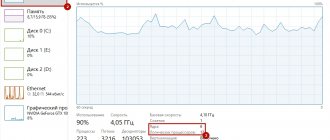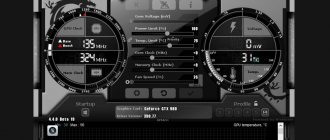Content:
- 1 Update index - what is it?
- 2 TV options based on storyboard
- 3 Technical description of the sweep
- 4 How to find out the refresh rate of a TV screen 4.1 Which indicator is better?
- 4.2 Does the refresh index affect the eyes?
- 5.1 TV resolution
The main characteristics of digital TV include display diagonal, supported resolutions, matrix type, monitor shape, screen scan or refresh rate. The last parameter is displayed in Hertz and is responsible for the quality of the final image. There is one for each TV class. Let's take a closer look at what the frequency index affects, what parameter is optimal and how important it is to take it into account when choosing digital equipment for the home.
Frequency setting for CRT displays
Therefore, we will pay special attention to setting up CRT displays. How to change the refresh rate of a CRT screen in Windows using the XP version as an example? Very simple. You need to log into the Control Panel. Then select “Screen”. Having opened the corresponding window, you need to find the “Settings” tab. Next - “Advanced”. There will most likely be a list of several options.
What screen refresh rate should I set? For CRT monitors, the recommended value is 85 Hz. If this number is not in the list, then this is most likely due to the fact that the factory video card driver is not installed on the PC. It must be downloaded on the Internet or searched for on the discs that came with the PC when it was sold. You can also try contacting a service center to ask for help with the driver.
Update index - what is it?
Modern monitors, laptop screens, and TV work on the principle of constant frame changes. This technology is similar to the principle of operation of a film projector. The speed of movement of pictures is so high that it is invisible to humans. The viewer sees a single video running without interference, stuttering or slowdown.
The monitor's refresh rate is shown and measured in Hertz. Their number shows the frame rate index per second. Previously, it was believed that the indicator should be in the range of 200 Hz. However, in modern technology, screen resolution plays an important role. For example, for 4K quality, a shift frequency of 60 - 120 Hz is sufficient.
In simple words, the TV's hertz must match the quality (resolution) of the image. Let's look at the optimal parameters and options for modern digital devices in more detail.
How to change the refresh rate
Windows allows you to change the display frequency. Finding this feature is very easy. To get started, follow this path to find out the refresh rate of your monitor. Next, regardless of the system, be it Windows 7, 8 or 10, you will see the item. And it will talk about frequencies that your device does not support. Initially this function is inactive. And the system itself warns that changing parameters may lead to malfunctions.
Once you check the box, you will see options with different monitor refresh rates. But don't rush to change them. The system does not just warn you about malfunctions. After all, otherwise the display may break. Or your image will simply disappear. And in this case, you will have to contact specialists.
If you are absolutely confident in your knowledge, then you can try changing this parameter as you please.
TV options based on storyboard
- Models with a scan rate of 60 Hz. These are the most affordable displays. They do not provide high detail. The image may appear blurred during fast-paced scenes. Watching videos ends up not being as comfortable as we would like. And in some situations, even the presence of flickering interferes with the video, which tires the eyes.
- Displays with 120 Hz Hertz are the best modern options with a good price-to-image quality ratio. These are the TVs that are the most popular. They are available in all digital and home appliance stores. You can find both expensive and medium-cost options.
Do not confuse the concept of monitor refresh rate with filming indicators. It is equivalent to 24 frames per second, which is only 50 frames on television.
Screen tearing problem
Since frame rates and refresh rates often vary, screen tearing is a common problem with PC games. This happens when your graphics card sends frames at a higher rate than your monitor can handle. If you try to play a high frame rate game on a low refresh rate monitor, you will encounter this issue. It will look like the screen is half loaded or "torn" down the middle.
To avoid this, games are usually automatically limited by your monitor's refresh rate. So if you have a 60Hz refresh rate monitor, your games shouldn't run at more than 60fps.
There are solutions to this problem such as G-Sync, V-Sync and Freesync.
Technical description of the sweep
To understand what the refresh rate of a TV screen affects, you need to understand the display options themselves on the market:
- LCD or liquid crystal displays. They have an affordable price. The image is formed using fluorescent CCFL illumination. Televisions transmit pictures with high definition. The average scan rate is 100 Hz, with no flickering or other interference affecting vision.
- LEDs are an improved version of LCD models. They are complemented by a LED lighting system. These monitors have a high contrast ratio. The area of the screens is different, it affects the final parameters of the picture. For example, models labeled Edge LED have edge-based backlight distribution. At the same time, the image with such placement of light sources is somewhat worse than that of classic LED TV.
- Plasma. Panel with plasma cells illuminated by UV rays. Plasma panels provide the highest contrast and color depth compared to the two previous versions. However, the service life of such a TV is only 3-4 years, which is compensated by its affordable price. During prolonged use, the panel heats up and the picture quality decreases. Other disadvantages include a noticeable decrease in the beauty of the video when using an external module.
- OLED are new versions of TV developed in 2020. The first models were bulky and were not in great demand. When flat-panel options appeared, the demand for TV increased. The uniqueness of this TV is the absence of backlighting with high contrast and ideal depth of black color.
Each of the listed TV versions works with different screen refresh rates. Information is received on the TV via non-switched communication channels at a speed of 50 frames per second. With the help of digital processing, the speed parameter is doubled. So, it turns out to be a hertz of 100 Hz.
In computer graphics, smooth movements and high clarity are achieved through the use of 2 main frames and a large number of intermediate intelligent connections. At the same time, PC monitors also have their own refresh rate.
Technological aspect
Almost similar patterns are also typical for other digital devices that use an LCD display. That is, for example, the refresh rate of a laptop screen is a parameter that is just as “closed” for adjustment as in the case of PC monitors.
In extremely rare cases, a possible difference in the quality of the image on the liquid crystal display depends on the set frequency values. Almost always, the key factor is the level of technology, which mainly determines the pixel refresh rate. It is less important what the screen refresh rate is set to. Which technology for constructing a picture is better in terms of “pixelization” and color rendition for a specific monitor model is determined first of all by the manufacturer brand. Outdated screens, of course, can “produce” not quite high-quality images. But as for modern products, significant problems with them, as a rule, do not arise. We also note that in addition to the “frequency” factor, the picture quality is affected by a large number of other parameters characteristic of PC and laptop screens. This is the resolution, matrix type, video card characteristics.
How to find out the refresh rate of a TV screen
When purchasing new digital equipment, you can find out the hertz rating from the seller or in the technical description of the device. In online stores, just open the technical parameters tab to see the screen update index.
If you want to find out a parameter in an already working TV, just go to the TV menu and open the technical data tab. You can also open the device passport and read all the information about the TV there.
The last option where to find all the information about the equipment is the manufacturer’s official website. There you will need to enter the brand, series and year of manufacture of the TV. Such information is available on a special sticker or plastic plate on the back panel of the equipment.
Which indicator is better?
There is no point in looking only at the refresh rate of the TV screen. Separately, this parameter does not affect the quality of picture reproduction. It comes complete with all the basic technical specifications.
It’s not worth buying a new TV with a Hertz signal less than 60 Hz. This is a very weak indicator that does not display modern image formats correctly. The optimal range for digital devices is from 100 - 120 Hz. At the same time, a number of high-resolution models show a smooth picture even at 60 Hz.
Advice. Choose a TV based on all parameters. You should not focus only on one indicator that, for example, friends or neighbors told you about.
Does the refresh index affect the eyes?
Only a low frame rate - up to 50 Hz - has a bad effect on human vision. With such a Hertz signal, flickering and glitches in the transmission of video files are noticeable. When watching programs for a long time, fatigue, irritability and headache appear.
All modern TVs support medium or high screen refresh rates, which are safe for human eyes. The proximity of the viewer to the display has more influence. It is not recommended to watch even the highest quality video at a distance closer than 1-1.5 meters.
CRT displays: nuances
Note that in almost all operating systems it is possible to change such a parameter as the screen refresh rate. Windows 7, as the most modern and seemingly not requiring significant intervention in settings on the part of the user, is no exception. In this version of the OS, the algorithm for setting the necessary parameters is almost the same. Through the “Control Panel” the desired screen refresh rate is set. Which operating system is better adapted to setting the appropriate settings? Almost all versions of Windows cope with the task in the same way. True, as for the latest versions of the OS (the same Windows 7), they may have some difficulties with drivers for outdated devices. But they can be solved - as a rule, any software of the appropriate type can be found on the Internet.
Also, when working in Windows 7, the algorithm for reaching the required settings is somewhat different from the scenario in XP. You need to enter the “Control Panel”, then click on “Screen”, then select changing its parameters. Then - “Advanced settings”. Next, go to the “Monitor” tab, where we find the frequency settings.
We also note that when you set all versions of the corresponding parameters in Windows, you should not uncheck the box next to the item “Hide modes that the monitor does not use.” The fact is that technologically the screen, of course, is capable of working with settings outside the recommended ones. But in practice, this can create problems with PC stability. Therefore, if a user is wondering how to change the screen refresh rate if the required parameter is not available, and the available values are lower than those desired for CRT screens, the first thing we recommend to him is to install the latest drivers on the video card.
Main characteristics of TV
Parameters that are very important to consider when choosing equipment:
- Matrix type. These are LCD, LCD, LED, plasma and OLED TVs.
- Resolution index.
- Contrast.
- Monitor diagonal.
- Viewing angle.
- Brightness.
- Types of connectors for connecting external equipment.
Let's look at each parameter in more detail.
TV resolution
The refresh rate of the TV screen works in tandem with the resolution. Modern versions include:
- HD is a digital format with an indicator of 720 pixels. Allows you to get colorful pictures without high detail.
- Full HD is a modern digital version of 1080p resolution. Supports three video files.
- 4K or Ultra HD is a new high-quality resolution that transmits 4 times more pixels than Full HD.
Important. No TV can display video with a better resolution than stated in the parameters of the equipment itself. If you connect a Blu-R ay console that streams movies in 4K to an HD TV , the quality on the screen will still be 720p.
Contrast
This parameter can be of two types: statistical and dynamic contrast. For the first option, the readings are measured in the maximum brightness difference within the frame. The ratio is shown in the 1000:1 option.
Dynamic contrast determines the overall cumulative difference obtained between the light and dark areas of one frame (scene).
Diagonal options
Technical parameter of the TV screen. It affects the comfort of video viewing. At the same time, manufacturers have developed recommendations for viewing different types of TV diagonals:
- The 2D format is best viewed at a distance equal to three diagonals of the television screen.
- 3D reproduction is better perceived at a distance of 1.5 times the screen parameter.
The recommendations can be called conditional, because TVs with a diagonal of 55 inches will have to be viewed at a distance of more than 4 m. Not all apartments have such areas.
Suitable viewing angle
Interesting fact. Only plasma manufacturers correctly display this parameter in the technical data sheet. It is equal to 170-180⁰. The same indicator is found in most modern versions of TV.
What does brightness affect?
The indicator directly affects the quality of image perception. For the viewer it will be either very dim, or bright, or optimal in color rendition. Modern TVs have brightness levels ranging from 300 to 2000 cd/m.
Modern connection connectors
This is a secondary but important parameter when choosing a TV. For example, via HDMI you can immediately connect an audio and visual channel from a broadcast source. That is, to connect a digital set-top box, personal computer, satellite receiver and TV, only one wire is required.
At the same time, HDMI is a digital connection interface that supports high image
, high frame rate and reverse sound. When using cable version 2.0, the high parameters of video sent from game consoles, receivers and Blu-Ray are fully preserved.
Additionally, the TV has antenna inputs and connectors for connecting tulips. New TV formats include an input for a state-of-the-art Displayport cable that transmits video at 8K resolution.
What refresh rate do monitors need?
The human eye is an amazing organ: it can instantly focus on any object, whether it is half a meter from the eyes or a hundred meters away.
It can detect even small movements in the periphery of vision. But at the same time, alas, it is inert, and therefore, if you show a person a series of pictures with a certain frequency, then starting from a certain number of pictures per second it will seem to us that these are no longer static images, but movement. But the question is: at what frequency does this happen? Let's start a little from afar - with the “technical structure” of the eye. It has two types of light-sensitive cells (photoreceptors): rods and cones. Rods are responsible for black-and-white vision, but at the same time they have low inertia. Cones are responsible for color vision, and their inertia is higher. In the central part of the human eye there are many cones and few rods, while in the periphery, on the contrary, rods predominate. This is reasonable - less inert rods can notice even a slight movement at the border of vision, and then we turn our heads and look at what kind of movement it is in the central part, where there are many cones, and we see a lion hiding in the bushes. But there are no monitors or televisions that completely cover the entire viewing angle, so we mostly look at it directly, that is, more inert cones are mainly used. But how inert are they? The first opinion is that 24 frames per second is enough for everyone, and filmmakers love it very much: it allows them to save film. This result was obtained purely experimentally - this is the minimum fps in the video, at which it still seems like a video to us, and not a slide show. But then why does 24 frames in a computer game seem not enough to us? The answer is simple - one frame captured by the camera is a superposition of everything that happened while the shutter was open. In other words, a racing car, when filmed with a camera, looks like this:
But in a game where each frame is a picture clearly calculated by the video card at each moment in time, any screenshot will look clear (unless, of course, the blur is done programmatically).
Therefore, 24 fps in a video is enough, since each frame contains information that allows you to glue it with both the previous and the next. But in games this is not the case, and 24 frames per second is not enough there. But how much fps do you need in games? The experimenters decided to take a different route - not showing the person the game, gradually increasing fps and asking if it had become smooth. They decided to determine the inertia of the eye, that is, the time it needs to process information about one frame. And it turned out to be about 20 ms, so it easily turns out that 50 fps is enough for the eye to be smooth. And here many make a somewhat incorrect conclusion - well, if 50 fps is enough, then I’ll take a monitor with a frequency of 60 Hz (with a small margin) and admire the smooth picture.
What is their mistake? But the mistake is that fps and Hz are not the same thing - the first is the frames that the matrix displays, and the second is the number of signals received per second. It would seem that even by definition these are one and the same thing. But we forget that monitors have a response time. For example, we need to change the color from gray to dark gray, and if we connect an oscilloscope, we will see that the matrix “enters” the color in as much as 34 ms:
But if we want to get 50 fps, then the delay should be no more than 20 ms, but here it’s one and a half times more. What does this mean? And this means that in dynamic scenes we will never see the correct colors, because the matrix simply does not have time to “get into” them - the frames change faster. Therefore, we see various picture artifacts in the form of trails and incorrect colors.
But what if we take a 120Hz matrix and compare it to a 60Hz matrix? The picture will be like this (frames are taken every 8.3 ms, which corresponds to 120 Hz):
It is clearly visible that the white trails behind objects at 120 Hz are much smaller. Moreover, color mismatches will also disappear much faster, and the color rendering errors themselves will be smaller, since now the change in brightness will occur not in one step, but in two, and the smaller the step, the smaller the miss. As a result, a picture at 120 Hz will indeed appear smoother, but not because the human eye can perceive 120 fps, but because such a matrix will have much fewer artifacts and reacts faster to changes in the picture.
Does it make sense to increase the frequency even higher - up to 240 Hz for example? It has - this will further reduce trails and mistakes in color. But today systems that can produce 240 frames per second in modern games in FHD are very expensive, so such monitors are not needed yet. But not the most expensive of modern Nvidia GTX 1080 video cards can already produce 120 fps, so if you have one, you can buy a monitor with a refresh rate of 120 Hz - the picture in games will become more pleasant.
General recommendations for choosing TV
Before buying a TV, you need to choose the type of matrix. You can read information about all displays: LCD, LCD, OLED, plasma. And choose the option that suits you best. Some options (LCD, plasma) are already outdated and are rarely found on store shelves.
After choosing the type of matrix, you should pay attention to all the technical parameters of the TV. And especially consider:
- Screen diagonal;
- Acceptable resolution, ability to view 3D video;
- Monitor refresh rate – 60 or 120 Hz. It must be combined with resolution.
- Level of contrast and brightness.
- Recommended TV viewing range depending on the diagonal.
- Availability of suitable connectors for connecting external devices.
You can read reviews of several modern TVs to understand what parameters buyers pay attention to first.
Found a mistake? Select it and press ctrl+enter
- 60
How does the screen refresh rate differ from the sensor frequency?
Sensor frequency affects the speed of reading actions on the screen / Source: Pinterest
Sensor frequency, also measured in Hz, explains how quickly the screen responds to touches. Every modern smartphone has a special sensor layer that also reads information in specified iterations - a certain number of times per second. The higher this value, the more responsive the device appears. The conditional delay time also depends on the refresh rate of the sensor, and this is what manufacturers of modern gaming smartphones pay most attention to. They are trying to find an additional advantage for gamers, which is especially important in online games.
In general, when a manufacturer says that a display has an increased refresh rate, you need to clarify what exactly they are talking about - either the matrix or the sensor. Both the first and second are quite important when using a smartphone or other device, but the characteristics are quite different.
Frames per second and monitor frequency: how are they related?
Discussions about the real need for high FPS values in games and monitors with high refresh rates have been going on for a long time. Many people believe that the race for hertz and frames per second does not make sense, especially when the monitor frequency does not exceed 60 Hz. Cybersport.ru will explain why more is better in any case and who it will help.
What is a person capable of?
From the very beginning of the development of cinematography and animation, a myth has appeared that 24 frames per second is the maximum that a person can recognize. Allegedly, there is absolutely no point in doing more, and the visual smoothness of the animation will not change in any way.
For a person, a slideshow turns into animation at a frequency of about 15 frames per second. But the higher the frame rate, the better the image is perceived. And 24 frames have nothing to do with physiology. This format is based more on economic and technical issues - film of those times and equipment for playback were the best in terms of price-quality ratio.
With the development of technology, people created new media, analog transmissions gave way to digital ones: we were able to move to 30 frames per second or more. For example, the IMAX system reproduces 48 frames per second, and game broadcasts on Twitch are up to 60 FPS. And just tell me that you don’t notice how the picture at 60 frames per second becomes smoother than at 30!
After 60 FPS, the difference at a higher frequency when watching a video is more difficult to catch. It depends more on the individual perception of each person. For example, in the American Air Force there was a test among fighter pilots. And they managed not only to notice the plane, which was displayed in one frame in the video sequence with a frequency of 220 frames per second, but also to name its model. So there is no exact answer to the question of how many frames a person can recognize.
What a monitor can do
Nowadays, most monitors have a refresh rate of 60 Hz. But technology has moved forward, and we can already make matrices that will output 120 Hz, 144, and even 240. But why? High-frequency monitors are significantly more expensive, and not everyone benefits. Modern video has a frequency of no more than 60 frames per second, which means there is little demand for monitors with higher refresh rates.
But if we are talking about games, then they produce much higher FPS values than video content. In Counter-Strike: Global Offensive, for example, the frequency is not limited at all. And the most experienced players experience lag at less than 300 FPS. To make the most of these frames per second, you need a monitor with a higher refresh rate.
Let's give a simple example. In the first case, you sit and watch from the side as someone plays CS:GO on a monitor with a refresh rate of 144 Hz and 300 FPS, and a person sits next to you with a 60 Hz monitor and 60 FPS in the game. There will be no obvious difference in the image for you. But if you sit in the players' seats, you will immediately feel that everything is happening more clearly, smoothly and accurately.
This can be proven with numbers. At 60 Hz the frame changes every 16 ms, and at 144 Hz every 6 ms. Despite the fact that an almost threefold difference will not be noticeable to the eye at all, a person’s fine motor skills, after several years of honing the skill of the game, use these 10 ms to more accurately aim the sight on the head. This cannot be explained in words, only felt. All eSports players, by the way, require the organizers to use 144 Hz monitors.
Firstly, the difference between any professional player and his opponent is so minuscule that even such little things can decide the outcome of the battle. Secondly, they play at this frequency everywhere - at home, at bootcamp and at other tournaments. For a long time they got used to 144 Hz. At a lower frequency, they will not only not be able to realize their potential and will feel severe discomfort. It will seem to them that everything is slow and laggy.
There are no extra shots
Can a 60Hz monitor display more than 60 frames per second? No, he can not. Another question is what exactly it will display. Displaying an image on the screen and rendering frames on a computer do not occur simultaneously. There is a slight delay called Input Lag. When you move the mouse or press a key, the screen will only apply it in the next frame.
If you are playing at 60 FPS, then the minimum difference between movement and display will be approximately 16 ms. If the frequency is twice as high, then before displaying the next frame the system has time to render two, and the more relevant one will be displayed on the screen. In total, the delay is halved. Based on this, the conclusion suggests itself: more FPS is always good, regardless of what the monitor’s refresh rate is.
The technique is not a cheat, but a tool
What would happen if you gave an ordinary person the coolest brush, paints, canvas and asked him to paint a masterpiece right here and now? Obviously, nothing will work out for him. In order to achieve results, you need practice, training and dexterity. If after a thousand hours of playing CS:GO on a 60 Hz monitor and with 60 FPS you still remain a silver, then no amount of monitors or FPS indicators will make you a major champion. The result is too strongly influenced by the human factor - form, mood, state, reaction and a host of other features. In no case should we reduce everything to technical aspects.
It all depends on your needs and capabilities. Some people are satisfied with even 30 FPS and they don’t see the point in spending several thousand dollars on a powerful computer with the latest hardware, much less on a monitor with a frequency of 120 Hz or more. Others feel poor control responsiveness even at 60 Hz, although they have never tried a higher frequency. And at the top level, everything should be the best - the skill of the players and the conditions in which they perform. In order for them to realize their maximum potential, they need tools with the highest possible performance. Professionals know how to implement these milliseconds collected bit by bit, and among opponents of equal skill, they decide the outcome of the battle.
Summarizing
Taking into account all relevant parameters, several conclusions can be drawn.
- Scanning provides a smooth image and a clear storyboard of moving objects.
- The resolution ensures realistic rendering of each frame, when you can see all the details; color, movement of water or people are accurately conveyed.
- When choosing which TV model is better, it is worth analyzing all the key characteristics together so that both the screen resolution and frame refresh rate are at the same level.
Also, feel free to include and compare the image in the store before purchasing. Consultants will never be able to describe in words the quality of the picture of a particular model. Maximum comfort and satisfaction from a new acquisition will be at its best if you approach the choice with a degree of criticality.











